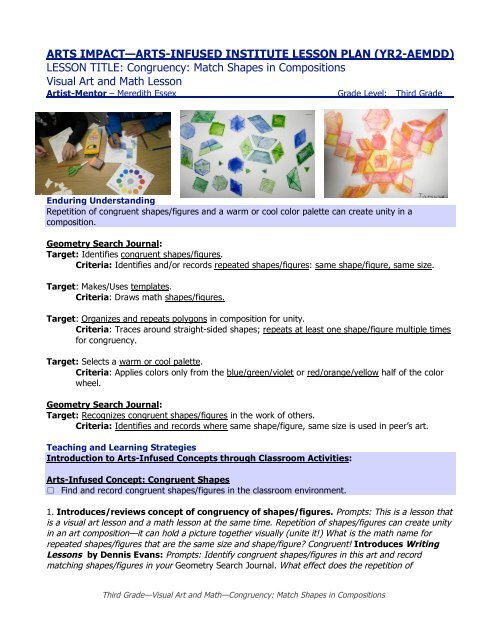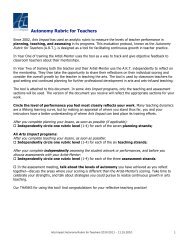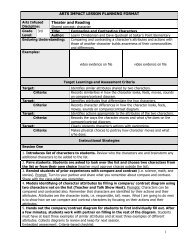Congruency: Match Shapes in Compositions Visual Art a - Arts Impact
Congruency: Match Shapes in Compositions Visual Art a - Arts Impact
Congruency: Match Shapes in Compositions Visual Art a - Arts Impact
- No tags were found...
You also want an ePaper? Increase the reach of your titles
YUMPU automatically turns print PDFs into web optimized ePapers that Google loves.
ARTS IMPACT—ARTS-INFUSED INSTITUTE LESSON PLAN (YR2-AEMDD)<br />
LESSON TITLE: <strong>Congruency</strong>: <strong>Match</strong> <strong>Shapes</strong> <strong>in</strong> <strong>Compositions</strong><br />
<strong>Visual</strong> <strong>Art</strong> and Math Lesson<br />
<strong>Art</strong>ist-Mentor – Meredith Essex<br />
Grade Level: Third Grade<br />
Endur<strong>in</strong>g Understand<strong>in</strong>g<br />
Repetition of congruent shapes/figures and a warm or cool color palette can create unity <strong>in</strong> a<br />
composition.<br />
Geometry Search Journal:<br />
Target: Identifies congruent shapes/figures.<br />
Criteria: Identifies and/or records repeated shapes/figures: same shape/figure, same size.<br />
Target: Makes/Uses templates.<br />
Criteria: Draws math shapes/figures.<br />
Target: Organizes and repeats polygons <strong>in</strong> composition for unity.<br />
Criteria: Traces around straight-sided shapes; repeats at least one shape/figure multiple times<br />
for congruency.<br />
Target: Selects a warm or cool palette.<br />
Criteria: Applies colors only from the blue/green/violet or red/orange/yellow half of the color<br />
wheel.<br />
Geometry Search Journal:<br />
Target: Recognizes congruent shapes/figures <strong>in</strong> the work of others.<br />
Criteria: Identifies and records where same shape/figure, same size is used <strong>in</strong> peer’s art.<br />
Teach<strong>in</strong>g and Learn<strong>in</strong>g Strategies<br />
Introduction to <strong>Art</strong>s-Infused Concepts through Classroom Activities:<br />
<strong>Art</strong>s-Infused Concept: Congruent <strong>Shapes</strong><br />
F<strong>in</strong>d and record congruent shapes/figures <strong>in</strong> the classroom environment.<br />
1. Introduces/reviews concept of congruency of shapes/figures. Prompts: This is a lesson that<br />
is a visual art lesson and a math lesson at the same time. Repetition of shapes/figures can create unity<br />
<strong>in</strong> an art composition—it can hold a picture together visually (unite it!) What is the math name for<br />
repeated shapes/figures that are the same size and shape/figure Congruent! Introduces Writ<strong>in</strong>g<br />
Lessons by Dennis Evans: Prompts: Identify congruent shapes/figures <strong>in</strong> this art and record<br />
match<strong>in</strong>g shapes/figures <strong>in</strong> your Geometry Search Journal. What effect does the repetition of<br />
Third Grade—<strong>Visual</strong> <strong>Art</strong> and Math—<strong>Congruency</strong>: <strong>Match</strong> <strong>Shapes</strong> <strong>in</strong> <strong>Compositions</strong>
shapes/figures have <strong>in</strong> this art What if every s<strong>in</strong>gle shape/figure was different What math<br />
understand<strong>in</strong>g does the artist use<br />
Student: Analyzes art and records shapes/figures <strong>in</strong> Geometry Search Journal. Checks for accuracy by<br />
compar<strong>in</strong>g notes with partner.<br />
Embedded Assessment: Criteria-based peer critique<br />
2 .Demonstrates creat<strong>in</strong>g OR us<strong>in</strong>g shape/figure templates to use <strong>in</strong> composition. Prompts:<br />
Your job is to use your math kit shape template OR cut a polygon template from tag-board<br />
<strong>in</strong> half to make two polygons. You can share your polygons with your neighbors so you have a<br />
group of straight-sided shapes with which to work.<br />
Student: Observes demonstration.<br />
3. Introduces/reviews warm and cool color us<strong>in</strong>g a color wheel. Prompts: What colors are cool<br />
colors, and what colors are warm colors Th<strong>in</strong>k water, forest, ice for cool...desert, sun and fire for<br />
warm colors. I am select<strong>in</strong>g pencils first that I will be us<strong>in</strong>g (you will be show<strong>in</strong>g the teacher that they<br />
all match the warm or cool side of the color wheel). I am go<strong>in</strong>g to choose either warm or cool colors for<br />
my whole composition: I choose cool colors for my art. So I’m look<strong>in</strong>g for the blues, greens, and violets<br />
for my palette. I am trac<strong>in</strong>g around each of my shapes/figures, but. . . .I need to have some repetition<br />
to help hold my composition together. I am go<strong>in</strong>g to trace at least one of my shapes/figures multiple<br />
times. I can po<strong>in</strong>t them <strong>in</strong> different directions or flip them, but they will still be congruent. If you have<br />
space, and want to repeat another shape/figure, mak<strong>in</strong>g them congruent, feel free to do that. Notice as<br />
I trace my shapes/figures, I am th<strong>in</strong>k<strong>in</strong>g about their placement. I want to fill up the space, but not<br />
overlap my shapes/figures. Same shape/figure—same size! They’re congruent!<br />
Now that my whole composition is filled with outl<strong>in</strong>es of shapes, and I have checked to makes sure that<br />
some are congruent, I can create patterns of color or shape, light and dark values, or solid color <strong>in</strong>side<br />
of all my shapes/figures until they are all filled with color. I am overlapp<strong>in</strong>g color <strong>in</strong> strokes of different<br />
direction and experiment<strong>in</strong>g with other effects while stick<strong>in</strong>g with my cool palette of pencils.<br />
Student: Observes demonstration.<br />
4. Guides creative process. Prompts: Don’t forget to check to make sure you have at least<br />
two shapes/figures that are the same size and have the same sides that are the same<br />
length. Check <strong>in</strong> too, with a partner and your teacher on pencil/palette choice—is it warm or cool<br />
Once you have all of your shapes drawn, po<strong>in</strong>t the congruent shapes/figures <strong>in</strong> your composition.<br />
Student: Creates art.<br />
Embedded Assessment: Criteria-based self-assessment.<br />
5. Demonstrates and guides technique possibilities for us<strong>in</strong>g water soluble colored pencils.<br />
Prompts: Once I have completely filed <strong>in</strong> all of my shapes and checked for congruency, I am go<strong>in</strong>g to<br />
use the water color pencil. Now I am carefully add<strong>in</strong>g a small amount of water us<strong>in</strong>g a barely wet,<br />
small brush—I can create brush effects, extend the color or blend it. I am be<strong>in</strong>g very thoughtful<br />
and careful to enhance, not distort my shapes. I can also dab away excess water on my brush or<br />
paper with a paper towel. It is very important that my shapes/figures are still clear <strong>in</strong> my composition,<br />
so I am not brush<strong>in</strong>g away my shape/figure outl<strong>in</strong>es.<br />
Student: Observes demonstration and creates watercolor effects.<br />
6. Facilitates criteria-based reflection: Displays art on the board. Prompts: F<strong>in</strong>d a work of art (of a<br />
classmate) and identify the congruent shapes/figures <strong>in</strong> their art. Note the artist and record<br />
properties/attributes—number of sides and length of sides/name of match<strong>in</strong>g shapes/figures <strong>in</strong> your<br />
Third Grade—<strong>Visual</strong> <strong>Art</strong> and Math—<strong>Congruency</strong>: <strong>Match</strong> <strong>Shapes</strong> <strong>in</strong> <strong>Compositions</strong>
Geometry Search Journal. What effect does the repetition of shapes/figures and a warm or cool color<br />
palette have <strong>in</strong> the art<br />
Student: Participates <strong>in</strong> critique.<br />
Embedded Assessment: Criteria-based class critique; criteria-based peer assessment<br />
Writ<strong>in</strong>g<br />
Classroom<br />
Writ<strong>in</strong>g Activity<br />
Classroom<br />
Activity<br />
ART<br />
Co- Teach<br />
ART<br />
Model/<br />
Co- Teach<br />
Writ<strong>in</strong>g<br />
Classroom<br />
Activity<br />
ART<br />
Supported<br />
Teach<br />
Writ<strong>in</strong>g<br />
Classroom<br />
Activity<br />
Writ<strong>in</strong>g<br />
Classroom<br />
Activity<br />
Independent<br />
Practice<br />
Writ<strong>in</strong>g<br />
WASL<br />
BEFORE next VISUAL ART lesson:<br />
Math Centers<br />
1. Cut out a picture with congruent math polygon shapes/figures from a magaz<strong>in</strong>e or other<br />
pr<strong>in</strong>ted material (build<strong>in</strong>gs with repeated congruent w<strong>in</strong>dow shapes/figures; fabrics with<br />
Math<br />
repeated polygon shapes/figures) and glue <strong>in</strong>to Geometry Search Journal. Label the<br />
congruent shapes/figures found with their properties/attributes: number of sides, etc.).<br />
Switch with a neighbor and see if any are missed!<br />
Math<br />
2. Draw an animal us<strong>in</strong>g math shape/figure templates or by trac<strong>in</strong>g around pattern blocks.<br />
Try mak<strong>in</strong>g an animal where there is only one pair of congruent shapes/figures, try mak<strong>in</strong>g<br />
another that is all congruent shapes/figures. Ask a classmate to identify the polygon<br />
shape/figure that helped to create the animal.<br />
Independent Practice: Congruent—same shape—same size! Count the sides to check!<br />
Vocabulary Materials and Community Resource WA Essential Learn<strong>in</strong>gs & Frameworks<br />
<strong>Art</strong>s:<br />
composition<br />
palette<br />
repetition<br />
template<br />
unity<br />
warm/cool color<br />
water soluble colored<br />
pencils<br />
<strong>Art</strong>s Infused:<br />
shape<br />
Math:<br />
congruence<br />
flip/reflection<br />
polygon<br />
Museum <strong>Art</strong>works:<br />
TAM: Dennis Evans, Writ<strong>in</strong>g Lessons, 2002<br />
color wheels<br />
<strong>Art</strong> Materials:<br />
Geometry Search Journals<br />
water soluble colored pencils<br />
tag board scraps pre-cut <strong>in</strong> small polygon shapes OR<br />
shape templates from math kits<br />
watercolor paper: 7 x 9 <strong>in</strong>.<br />
scissors<br />
paper towels<br />
small nylon brushes<br />
water conta<strong>in</strong>ers<br />
AEL 1.1 concepts: shape, warm/cool color palette,<br />
unity, repetition<br />
AEL 1.2 skills and techniques: draw<strong>in</strong>g/pa<strong>in</strong>t<strong>in</strong>g<br />
AEL 4.2 connections between arts and other content<br />
areas: geometry: congruent shapes<br />
Math State Frameworks<br />
Grade 4: describes and compares congruent 2D<br />
figures; draws a shape that is congruent to a given<br />
2D shape<br />
Grade 4: solves problems <strong>in</strong>volv<strong>in</strong>g congruence<br />
creates a design made out of congruent shapes<br />
Grade 5: draws congruent figures and shapes <strong>in</strong><br />
multiple orientations us<strong>in</strong>g a transformation<br />
Third Grade—<strong>Visual</strong> <strong>Art</strong> and Math—<strong>Congruency</strong>: <strong>Match</strong> <strong>Shapes</strong> <strong>in</strong> <strong>Compositions</strong>
ARTS IMPACT—ARTS-INFUSED INSTITUTE LESSON PLAN (YR2-AEMDD)<br />
LESSON TITLE: <strong>Congruency</strong>: <strong>Match</strong> <strong>Shapes</strong> <strong>in</strong> <strong>Compositions</strong><br />
ASSESSMENT WORKSHEET<br />
Discipl<strong>in</strong>es ART AND MATH ART ART AND MATH<br />
Concept SHAPE: Congruent Palette: Warm/Cool SHAPE:<br />
Congruent<br />
Student<br />
1.<br />
2.<br />
3.<br />
4.<br />
5.<br />
6.<br />
7.<br />
8.<br />
9.<br />
10.<br />
11.<br />
12.<br />
13.<br />
14.<br />
15.<br />
16.<br />
17.<br />
18.<br />
19.<br />
20.<br />
21.<br />
22.<br />
23.<br />
24.<br />
25.<br />
26.<br />
27.<br />
28.<br />
Total<br />
Percentage<br />
Identifies and<br />
records repeated<br />
shapes/figures:<br />
same<br />
shape/figure,<br />
same size <strong>in</strong><br />
(TAM) art<br />
Draws<br />
math<br />
shapes/<br />
figures<br />
Traces around<br />
straight-sided<br />
shapes; repeats at<br />
least one<br />
shape/figure<br />
multiple times for<br />
congruency.<br />
Applies colors only<br />
from the<br />
blue/green/violet or<br />
red/orange/yellow<br />
half of the color<br />
wheel<br />
Identifies and<br />
records where<br />
same<br />
shape/figure,<br />
same size is used<br />
<strong>in</strong> peer’s art<br />
Criteria-based Reflection Questions: (Note examples of student reflections.)<br />
Self-Reflection: What effect does the repetition of shapes/figures and color palette have <strong>in</strong><br />
this art Where is the math congruency <strong>in</strong> the art<br />
Peer to Peer: Check <strong>in</strong> with a partner on pencil/palette choice—is it warm or cool Look at a<br />
classmate’s art and identify the congruent shapes. Record properties/attributes and names of<br />
match<strong>in</strong>g shapes/figures <strong>in</strong> Geometry Search Journal.<br />
Thoughts about Learn<strong>in</strong>g:<br />
Which prompts best communicated concepts Which lesson dynamics helped or h<strong>in</strong>dered learn<strong>in</strong>g<br />
Total<br />
5<br />
Lesson Logistics:<br />
Which classroom management techniques supported learn<strong>in</strong>g<br />
Teacher:<br />
Date:<br />
Third Grade—<strong>Visual</strong> <strong>Art</strong> and Math—<strong>Congruency</strong>: <strong>Match</strong> <strong>Shapes</strong> <strong>in</strong> <strong>Compositions</strong>
ARTS IMPACT—ARTS-INFUSED LEARNING FAMILY LETTER<br />
VISUAL ART AND MATH – <strong>Congruency</strong> – <strong>Match</strong> <strong>Shapes</strong> <strong>in</strong> <strong>Compositions</strong>!<br />
Dear Family:<br />
Today your child participated <strong>in</strong> a visual art and math lesson.<br />
We identified congruent shapes/figures <strong>in</strong> Writ<strong>in</strong>g Lessons, a work of art by Dennis Evans.<br />
• We talked about and recorded where (the same shape/figure: number and length of sides and<br />
size) congruent shapes/figures are seen <strong>in</strong> art.<br />
• We used shape/figure templates to trace shapes on small pieces of watercolor paper.<br />
• We organized and repeated shapes/figures <strong>in</strong> composition for unity—we repeated at least<br />
two of the same shapes/figures to make them congruent.<br />
• We selected and used a cool color palette—blue/violet/green or warm or a warm color<br />
palette—yellow/orange/red to also unify our composition. We applied color us<strong>in</strong>g watersoluble<br />
colored pencils.<br />
You could make art us<strong>in</strong>g congruent shapes/figures by trac<strong>in</strong>g around simple objects multiple times.<br />
You could also hide congruent shapes/figures <strong>in</strong> complex compositions with many, many shapes/figures<br />
and challenge others to f<strong>in</strong>d them.<br />
Endur<strong>in</strong>g Understand<strong>in</strong>g<br />
Repetition of congruent shapes/figures and a warm or cool color palette<br />
can create unity <strong>in</strong> a composition.<br />
Third Grade—<strong>Visual</strong> <strong>Art</strong> and Math—<strong>Congruency</strong>: <strong>Match</strong> <strong>Shapes</strong> <strong>in</strong> <strong>Compositions</strong>
















